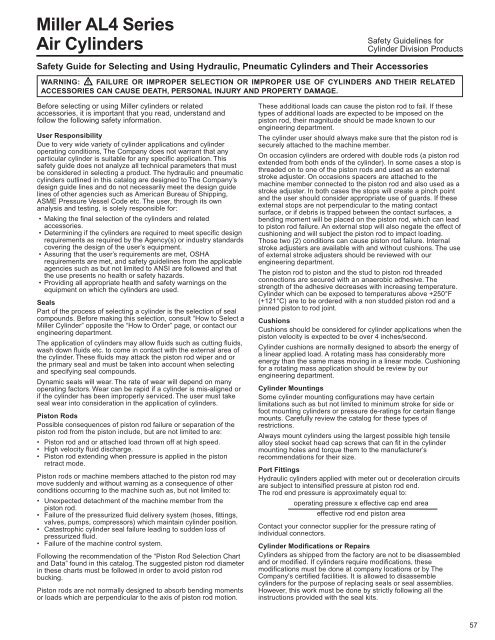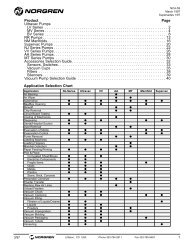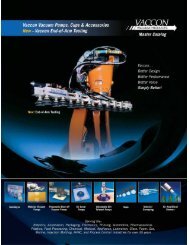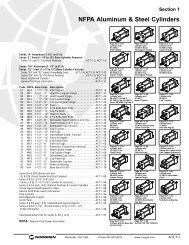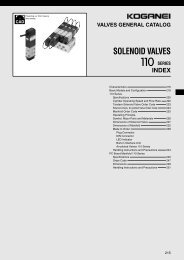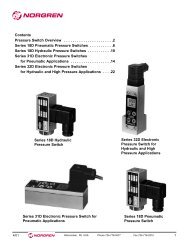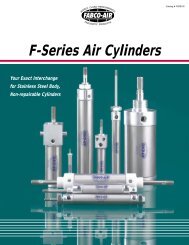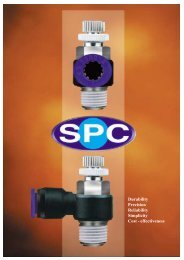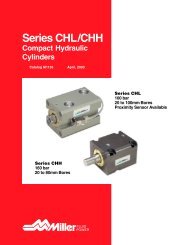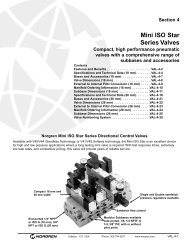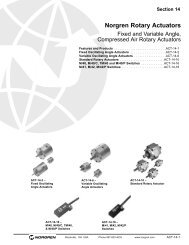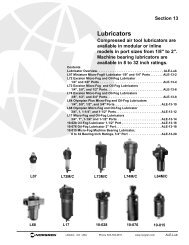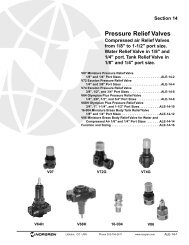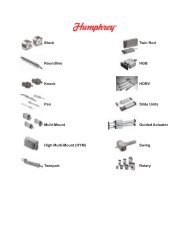<strong>Miller</strong> <strong>AL4</strong> <strong>Series</strong>Air CylindersStorageInstallationMounting RecommendationsCylinder Trouble ShootingStorageAt times cylinders are delivered before a customer is ready to installthem and must be stored for a period of time. When storage is requiredthe following procedures are recommended.1. Store the cylinders in an indoor area which has a dry, clean andnoncorrosive atmosphere. Take care to protect the cylinder fromboth internal corrosion and external damage.2. Whenever possible cylinders should be stored in a vertical position(piston rod up). This will minimize corrosion due to possiblecondensation which could occur inside the cylinder. This will alsominimize seal damage.3. Port protector plugs should be left in the cylinder until the time ofinstallation.4. If a cylinder is stored full of hydraulic fluid, expansion of the fluiddue to temperature changes must be considered. Installing a checkvalve with free flow out of the cylinder is one method.Installation1. Cleanliness is an important consideration, and <strong>Miller</strong> cylinders areshipped with the ports plugged to protect them from contaminantsentering the ports. These plugs should not be removed until thepiping is to be installed. Before making the connection to thecylinder ports, piping should be thoroughly cleaned to remove allchips or burrs which might have resulted from threading or flaringoperations.2. Cylinders operating in an environment where air drying materialsare present such as fast-drying chemicals, paint, or weld splatter, orother hazardous conditions such as excessive heat, should haveshields installed to prevent damage to the piston rod and piston rodseals.3. Proper alignment of the cylinder piston rod and its mating componenton the machine should be checked in both the extended andretracted positions. Improper alignment will result in excessive rodgland and/or cylinder bore wear. On fixed mounting cylindersattaching the piston rod while the rod is retracted will help inachieving proper alignment.Mounting Recommendations1. Always mount cylinders using the largest possible high tensile alloysteel socket head screws that can fit in the cylinder mounting holesand torque them to the manufacturer’s recommendations for theirsize.2. Side-Mounted Cylinders – In addition to the mounting bolts,cylinders of this type should be equipped with thrust keys or dowelpins located so as to resist the major load.3. Tie Rod Mounting – Cylinders with tie rod mountings are recommendedfor applications where mounting space is limited. Thestandard tie rod extension is shown as BB in dimension tables.Longer or shorter extensions can be supplied. Nuts used for thismounting style should be torqued to the same value as the tie rodsfor that bore size.4. Flange Mount Cylinders – The controlled diameter of the rod glandextension on head end flange mount cylinders can be used as apilot to locate the cylinders in relation to the machine. Afteralignment has been obtained, the flanges may be drilled for pins ordowels to prevent shifting.5. Trunnion Mountings – Cylinders require lubricated bearing blockswith minimum bearing clearances. Bearing blocks should becarefully aligned and rigidly mounted so the trunnions will not besubjected to bending moments. The rod end should also be pivotedwith the pivot pin in line and parallel to axis of the trunnion pins.6. Clevis Mountings – Cylinders should be pivoted at both ends withcenterline of pins parallel to each other. After cylinder is mounted,be sure to check to assure that the cylinder is free to swing throughits working arc without interference from other machine parts.Cylinder Trouble ShootingExternal Leakage1. Rod seal leakage can generally be traced to worn or damagedseals. Examine the piston rod for dents, gouges or score marks,and replace piston rod if surface is rough.Rod seal leakage could also be traced to gland bearing wear. Ifclearance is excessive, replace rod gland and seal. Rod sealleakage can also be traced to seal deterioration. If seals are soft orgummy or brittle, check compatibility of seal material with lubricantused if air cylinder, or operating fluid if hydraulic cylinder. Replace withseal material, which is compatible with these fluids. If the seals arehard or have lost elasticity, it is usually due to exposure to temperaturesin excess of 165°F. (+74°C). Shield the cylinder from the heatsource to limit temperature to 350°F. (+177°C.) and replace withfluorocarbon seals.2. Cylinder body seal leak can generally be traced to loose tie rods.Torque the tie rods to manufacturer’s recommendation for thatbore size.Excessive pressure can also result in cylinder body seal leak.Determine maximum pressure to rated limits. Replace seals andretorque tie rods as in paragraph above. Excessive pressure can alsoresult in cylinder body seal leak. Determine if the pressure rating of thecylinder has been exceeded. If so, bring the operating pressure downto the rating of the cylinder and have the tie rods replaced.Pinched or extruded cylinder body seal will also result in a leak.Replace cylinder body seal and retorque as in paragraph above.Cylinder body seal leakage due to loss of radial squeeze which showsup in the form of flat spots or due to wear on the O.D. or I.D. – Either ofthese are symptoms of normal wear due to high cycle rate or length ofservice. Replace seals as per paragraph above.Internal Leakage1. Piston seal leak (by-pass) 1 to 3 cubic inches per minute leakage isconsidered normal for piston ring construction. Virtually no static leakwith lipseal type seals on piston should be expected. Piston seal wearis a usual cause of piston seal leakage. Replace seals as required.2. With lipseal type piston seals excessive back pressure due to overadjustmentof speed control valves could be a direct cause of rapidseal wear. Contamination in a hydraulic system can result in a scoredcylinder bore, resulting in rapid seal wear. In either case, replace pistonseals as required.3. What appears to be piston seal leak, evidenced by the fact that thecylinder drifts, is not always traceable to the piston. To make sure, it issuggested that one side of the cylinder piston be pressurized and thefluid line at the opposite port be disconnected. Observe leakage. Ifnone is evident, seek the cause of cylinder drift in other componentparts in the circuit.Cylinder Fails to Move the Load1. Pneumatic or hydraulic pressure is too low. Check the pressure at thecylinder to make sure it is to circuit requirements.2. Piston Seal Leak – Operate the valve to cycle the cylinder and observefluid flow at valve exhaust ports at end of cylinder stroke. Replacepiston seals if flow is excessive.3. Cylinder is undersized for the load – Replace cylinder with one of alarger bore size.4. Piston rod broken. Bring the operating conditions of the cylinder to theattention of our engineering department and have our factory repair thecylinder.Erratic or Chatter Operation1. Excessive friction at gland or piston bearing due to load misalignment–Correct cylinder-to-load alignment.2. Cylinder sized too close to load requirements – Reduce load or installlarger cylinder.3. Erratic operation could be traced to the difference between static andkinetic friction. Install speed control valves to provide a back pressureto control the stroke.56
<strong>Miller</strong> <strong>AL4</strong> <strong>Series</strong>Air CylindersSafety Guidelines forCylinder Division ProductsSafety Guide for Selecting and Using Hydraulic, Pneumatic Cylinders and Their AccessoriesWARNING: ! FAILURE OR IMPROPER SELECTION OR IMPROPER USE OF CYLINDERS AND THEIR RELATEDACCESSORIES CAN CAUSE DEATH, PERSONAL INJURY AND PROPERTY DAMAGE.Before selecting or using <strong>Miller</strong> cylinders or relatedaccessories, it is important that you read, understand andfollow the following safety information.User ResponsibilityDue to very wide variety of cylinder applications and cylinderoperating conditions, The Company does not warrant that anyparticular cylinder is suitable for any specific application. Thissafety guide does not analyze all technical parameters that mustbe considered in selecting a product. The hydraulic and pneumaticcylinders outlined in this catalog are designed to The Company’sdesign guide lines and do not necessarily meet the design guidelines of other agencies such as American Bureau of Shipping,ASME Pressure Vessel Code etc. The user, through its ownanalysis and testing, is solely responsible for:• Making the final selection of the cylinders and relatedaccessories.• Determining if the cylinders are required to meet specific designrequirements as required by the Agency(s) or industry standardscovering the design of the user’s equipment.• Assuring that the user’s requirements are met, OSHArequirements are met, and safety guidelines from the applicableagencies such as but not limited to ANSI are followed and thatthe use presents no health or safety hazards.• Providing all appropriate health and safety warnings on theequipment on which the cylinders are used.SealsPart of the process of selecting a cylinder is the selection of sealcompounds. Before making this selection, consult “How to Select a<strong>Miller</strong> Cylinder” opposite the “How to Order” page, or contact ourengineering department.The application of cylinders may allow fluids such as cutting fluids,wash down fluids etc. to come in contact with the external area ofthe cylinder. These fluids may attack the piston rod wiper and orthe primary seal and must be taken into account when selectingand specifying seal compounds.Dynamic seals will wear. The rate of wear will depend on manyoperating factors. Wear can be rapid if a cylinder is mis-aligned orif the cylinder has been improperly serviced. The user must takeseal wear into consideration in the application of cylinders.Piston RodsPossible consequences of piston rod failure or separation of thepiston rod from the piston include, but are not limited to are:• Piston rod and or attached load thrown off at high speed.• High velocity fluid discharge.• Piston rod extending when pressure is applied in the pistonretract mode.Piston rods or machine members attached to the piston rod maymove suddenly and without warning as a consequence of otherconditions occurring to the machine such as, but not limited to:• Unexpected detachment of the machine member from thepiston rod.• Failure of the pressurized fluid delivery system (hoses, fittings,valves, pumps, compressors) which maintain cylinder position.• Catastrophic cylinder seal failure leading to sudden loss ofpressurized fluid.• Failure of the machine control system.Following the recommendation of the “Piston Rod Selection Chartand Data” found in this catalog. The suggested piston rod diameterin these charts must be followed in order to avoid piston rodbucking.Piston rods are not normally designed to absorb bending momentsor loads which are perpendicular to the axis of piston rod motion.These additional loads can cause the piston rod to fail. If thesetypes of additional loads are expected to be imposed on thepiston rod, their magnitude should be made known to ourengineering department.The cylinder user should always make sure that the piston rod issecurely attached to the machine member.On occasion cylinders are ordered with double rods (a piston rodextended from both ends of the cylinder). In some cases a stop isthreaded on to one of the piston rods and used as an externalstroke adjuster. On occasions spacers are attached to themachine member connected to the piston rod and also used as astroke adjuster. In both cases the stops will create a pinch pointand the user should consider appropriate use of guards. If theseexternal stops are not perpendicular to the mating contactsurface, or if debris is trapped between the contact surfaces, abending moment will be placed on the piston rod, which can leadto piston rod failure. An external stop will also negate the effect ofcushioning and will subject the piston rod to impact loading.Those two (2) conditions can cause piston rod failure. Internalstroke adjusters are available with and without cushions. The useof external stroke adjusters should be reviewed with ourengineering department.The piston rod to piston and the stud to piston rod threadedconnections are secured with an anaerobic adhesive. Thestrength of the adhesive decreases with increasing temperature.Cylinder which can be exposed to temperatures above +250°F(+121°C) are to be ordered with a non studded piston rod and apinned piston to rod joint.CushionsCushions should be considered for cylinder applications when thepiston velocity is expected to be over 4 inches/second.Cylinder cushions are normally designed to absorb the energy ofa linear applied load. A rotating mass has considerably moreenergy than the same mass moving in a linear mode. Cushioningfor a rotating mass application should be review by ourengineering department.Cylinder MountingsSome cylinder mounting configurations may have certainlimitations such as but not limited to minimum stroke for side orfoot mounting cylinders or pressure de-ratings for certain flangemounts. Carefully review the catalog for these types ofrestrictions.Always mount cylinders using the largest possible high tensilealloy steel socket head cap screws that can fit in the cylindermounting holes and torque them to the manufacturer’srecommendations for their size.Port FittingsHydraulic cylinders applied with meter out or deceleration circuitsare subject to intensified pressure at piston rod end.The rod end pressure is approximately equal to:operating pressure x effective cap end areaeffective rod end piston areaContact your connector supplier for the pressure rating ofindividual connectors.Cylinder Modifications or RepairsCylinders as shipped from the factory are not to be disassembledand or modified. If cylinders require modifications, thesemodifications must be done at company locations or by TheCompany's certified facilities. It is allowed to disassemblecylinders for the purpose of replacing seals or seal assemblies.However, this work must be done by strictly following all theinstructions provided with the seal kits.57


